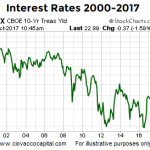In the era of crypto-currencies, I propose a new economic statistic: Gross Imaginary Product. This can be defined as the total output at market prices of all products and services which do not actually exist. Contrary to popular superstition, not all the $350 billion value of crypto-currencies is imaginary; there are some real values there. Conversely, in the physical economy, in California, London, Japan and everywhere that “funny money” has distorted it, there are apparently “real” values that are in truth purely imaginary. Needless to say, GIP has soared in an era of fraud and fantasy like the present, and appears to be at an all-time high.
The first recorded instances of Gross Imaginary Product, were the twin financings, equity for “a company for carrying out an undertaking of great advantage, but nobody to know what it is” in 1720 and the bond issue for the non-existent Republic of Poyais in 1822 (the latter was given credibility by the description of the capital’s imaginary cathedral.) These were both quite small deals, however, and merely scratched the surface of what subsequent bull markets showed to be possible.
In 1920, an especially famous though modest example of GIP was devised by Charles Ponzi, who absorbed some $20 million of people’s savings in a scheme to make an arbitrage profit out of international postal coupons. Again however, despite this scheme’s fame, $20 million was only 0.022% of 1920’s GDP of $88 billion; GIP was not yet a significant factor in the economy.
In 1963, the Great Salad Oil swindle involved loans being issued against $150 million of salad oil when only $8 million worth was in the tanks – inspectors would be fooled by tanks filled with water, with just a little salad oil on top. The GIP from this scheme alone was again about 0.022% of GDP of $650 billion – the GIP/GDP ratio had not increased significantly over the intervening 43 years.
The 2008 financial crash saw an upsurge in GIP. In housing finance, there was a huge volume of “subprime” mortgages, loans to people who had neither the income nor the prospects to have any chance of repaying them. Then there was the Bernie Madoff scam, when around $36 billion was invested in imaginary assets, with $18 billion repaid to early investors, some of whom got out with profits. The GIP in 2008 appears to have been some $100 billion, counting Madoff, fictitious subprime loans and fictitious derivatives and CDO squared contracts. This represented about 0.7% of U.S. GDP, already 30 times the relative size in 1920 and 1963.














Leave A Comment